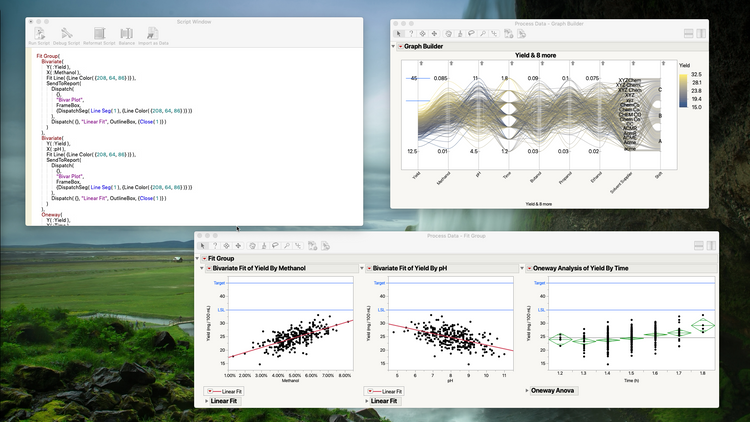 This simple action changed how I work over the course of a lunch break. It was that life-altering.We're here! We made it! The fifth thing I wish someone had told me! The true secret to JMP mastery! The wisdom of the elders awaits us all!
This simple action changed how I work over the course of a lunch break. It was that life-altering.We're here! We made it! The fifth thing I wish someone had told me! The true secret to JMP mastery! The wisdom of the elders awaits us all!
If you're just tuning into the series, sorry for the sarcasm... it's just what I do. Also, here's a brief recap of what you missed:
- I'm listing five* things I wish someone had told me on Day 1 of using JMP software.
- Thing 1: Always start with a graph.
- Thing 2: The 4-step JMP workflow everyone should know.
- Thing 3: Why the Analyze menu is set up the way it is.
- Thing 4: Don't underestimate the Distribution platform.
And now on to...
The Secret of the JMP Masters
There is one common thread among the most proficient JMP users: They. Save. Their. Dang. Work! And by "save. their. dang. work!" I mean they use the automatic code generation capabilities in JMP. This simple action lets them recreate their analyses in their current data set and allows them to rerun the analysis with new or updated data. When I figured this one trick out, it completely changed how I worked in JMP. And I don't mean it changed how I work (hyperbolically) "overnight." I mean (quite literally) that it changed how I work over the course of a lunch break. It was that life-altering.
Now before I go any further, some of you are probably hyperventilating because I mentioned coding. Take a second – breathe – think of puppies – go and get a cup of tea. It's not that big of a deal. For what we're going to discuss here, the software writes the code for you. If "script" makes you nervous, mentally substitute "macro" or "recipe" in. That's all that's going on. Better? OK, let's press on.
JMP is designed to write JSL code for you. This is done by using one of the options from the "Save Script" submenu under the Red Triangle menu (Answer Button). And that one trick is incredibly critical to JMP mastery. Experts in JMP understand how each of the different ways they can save a script increases their efficiency and saves them time in the long run. Here are the ones that you need to know first. 
Save Script To Data Table...
This is the first option that most people use. It creates a script in the data table's script area that can be rerun by clicking the green Go button. The critical thing to note about scripts is that they are saving the method used to create a particular report, not the report itself. This means that if the data is changed, or additional data is added to the table, running the saved script will incorporate those changes. Think about that for a second. The possibilities of that one little feature are boundless. Saved scripts in a JMP data table
Saved scripts in a JMP data table
The other powerful thing about table scripts is that they are portable. As long as the column names are the same, you can copy a script in one table, paste it into a new one, and it will run just fine using the new data. This allows new users to start automating their workflows and also share those workflows with others through data tables.
I can tell you from personal experience how powerful this method is. Remember that lunch break? My first exposure to scripting in JMP was using the Save Script to Data Table option to cut a weekly report that took two days to generate down to around 45 minutes (including all the PowerPoint tweaking and word-smithing). I learned this little trick while watching a video I stumbled into on the web over my lunch break. I automated the whole thing using table scripts. And when it came time for someone else to own that report, I just handed the data table with the scripts over to them. They could reproduce the report without any further issues. I really wish someone had told me this little trick on Day 1.
Save Script To Script Window (or Clipboard)
Both of these methods are critical for learning scripting. Saving scripts to a new script window lets a new coder learn about the structure of JSL commands. It also allows them to be more efficient by letting JMP write the bulk of the code for them. My second leap in scripting came using this method. I strung together Graph Builder and Tabulate reports into a custom application. It was predominantly written by JMP itself, and I was able to retain all the interactivity, etc., that people love about JMP reports. Examples of JMP Reports and the results of the Save Script to Script Window workflow.
Examples of JMP Reports and the results of the Save Script to Script Window workflow.
And, that's it... the five things I wish someone had told me when I started JMP. I hope you found them helpful.
You know, if we look back at the beginning of this series, it all got started with a bit of nostalgia. I had another nostalgic moment a couple of weeks ago. I was cleaning out a closet and found my first iPhone, and I remembered watching those old Apple product launches. You may have seen them. Steve Jobs was known as a master showman. We always knew things were going to get real when he would utter those famous words: "Oh, and one more thing..." Good times. Anyway, thanks for reading.
Oh, and one more thing...
You must be a registered user to add a comment. If you've already registered, sign in. Otherwise, register and sign in.